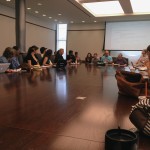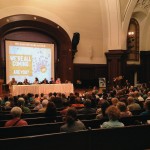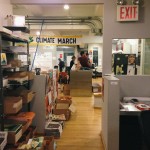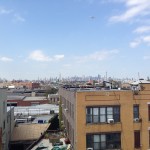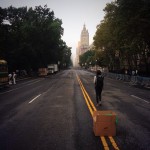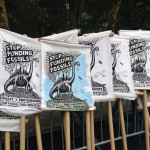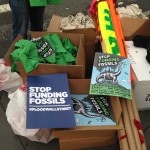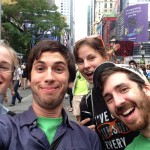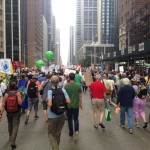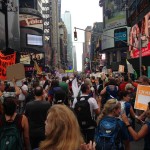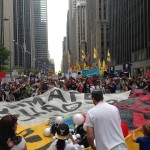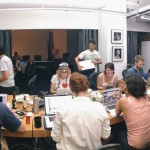It has been a full six months since the People’s Climate March took place in New York City. What’s weird is that the march feels like it happened both years ago and yesterday.
It was one of those momentous occasions that exists outside the normal ‘life narrative’ — it’s unstuck from time.
Luckily, I was recently asked to talk with some SustainUS Lead Now fellows about my experience organizing the People’s Climate March — and it all came rushing back. While things are still (relatively) fresh in my mind, I decided to jot down some thoughts.
I’m sure I’ll continue to reflect and develop a more refined perspective on the organization and impact of the march as time goes on, but having a starting point written down is always helpful.
I should preface all this by saying that I was one person in what was a MASSIVE collective effort and I only ever fully saw a slice of everything that was going on at any given time. Most of my time was spent helping to support the National Table (the entity connecting national groups working on the march) and the (surprisingly tiny) Digital Team.
So, with that, some thoughts.
Things we did well and reasons we succeeded:
- Clear Goal: Early on we established that the overarching objective of the march was turning out numbers in the streets of NYC. This helped keep things focused and helped knit the huge number of groups together.
- Locally Led: Another clear decision early on was that, to do this right, the march needed to be locally led. And it was — the ‘Host Committee’, made up of volunteers and staff from New York and New Jersey, put in an incredible amount of work. This wasn’t about having local environmental justice organizations and leaders at the table, they truly led the organizing effort from start to finish.
- ‘Frontlines Up Front’: In addition to being locally led, there was a refreshing self-awareness within the organizing space that the climate movement has often spectacularly failed to adequately support those on the frontlines of climate change and extractive industries. The Jemez Principles were core organizing principles for the march and the brilliant march lineup further reinforced our commitment to supporting and lifting up those voices and communities so often left behind. This wasn’t a ‘climate march’, this was a ‘climate justice march’. A critical distinction for those who spend a lot of time in this space.
- Broad Ownership: Some of the ‘heavy hitter’ organizations helped get the People’s Climate March rolling, but it quickly ballooned from there. The march slogan was “To Change Everything, We Need Everyone,” and I think we did a good job embodying that. At the end of the day we had over 1,500 organizations signed on as march partners and it never felt like a single organization was running the show or getting the credit for what we were building together.
- Arts and Creativity: If there was something that surprised me during the organizing of the march, it was how critical the arts track was from the very start — and not just in the ways one might traditionally think. The artists and cultural communicators weren’t just making beautiful things, they were planting deep seeds that are still continuing to sprout. The community engagement events, the meeting facilitation, the actions, having an actual space in the Mayday Space, the incredibly ambitious art projects… all of this was absolutely critical to the success of the march and #FloodWallStreet. And, as a result, our march was gorgeous in so many ways.
- About the People: As the name suggests, this march was about the people. The event was cleverly hooked to the UN Climate Summit happening the following Tuesday, but influencing the outcome of that meeting was in no way the point of what took place on September 21st. The celebrities, politicians, executive directors — none of them were the point of the march. This wasn’t just refreshing, it was what made the mood during the March electric and one that felt truly powerful. Every person on the street was an equal partner in our struggle for climate justice.
- #FloodWallStreet: Even though it wasn’t an official part of the People’s Climate March, what happened the next day was just as important in terms of cementing what we built. #FloodWallStreet helped provide an outlet for those looking for something more than ‘just another march’, and it was hugely successful. Even though it was much smaller than the March, #FloodWallStreet, in many ways, felt just as powerful. I still get shivers thinking about the day I spent surrounded by thousands of amazing friends and comrades as we sat in the middle of traffic next to Wall Street’s ‘Charging Bull’ on Broadway. It felt like the escalation that’s so desperately needed and I wish there were more moments like that one.
Things we could have done better:
- No Demands: One of the biggest misses, but also one that couldn’t be easily avoided, was a lack of any centralized demands. This wasn’t an oversight, it was an intentional choice to make sure we were able to bring the broadest number of organizations on board as possible. And it worked. But it still stung not having even a basic list of demands we could point to and say we agreed on. Instead, we left a lot of room for organizations and individuals to say whatever they wanted. We didn’t restrict folks. But I still would have loved to have had even a basic outline of shared priorities (like keeping fossil fuels in the ground or ending fossil fuel subsidies — the no brainer stuff).
- Decision Making Structure: When you’ve got four months to plan the largest climate march in history, decisions sometimes get made quickly. At the outset, the plan was to make the march decision making structure as horizontal as possible and, in many ways, we succeeded. Groups were given a lot of autonomy to set their own priorities. But there wasn’t always much guidance on ways to get involved. This got better as time went on, but it also became clear some major decisions needed to be made by a smaller group (like what day the march would be on and what route it would take). I would have loved to see this high level decision making process be more transparent, but can understand why it was necessary and undertaken in the way it was.
- Supporting Hubs: One organizing structure put in place early on with massive potential was the hub structure. It was our way to allow individuals to self-organize based on issue area, geographic region, or personal identity. And it worked, brilliantly in some cases. It was one of the few spaces actually doing the deep organizing work necessary to build and sustain the movement. But it was also, at times, a space poorly supported by the broader march apparatus. This became particularly clear after the march, when folks still wanted to stay involved but there was no clear plan to continue supporting the hubs. Which leads to the next point…
- No Clear Next Steps: Another big miss was not spending enough time on a clear follow-up plan. I suspect most folks were so busy focusing on September 21st, that nobody felt they had time to think about the ‘after’ question. I know that’s how I felt. There were some basic infrastructure decisions made and a committee set up to handle the email list that was generated, but without any immediate places to point people or ways to harness energy, it felt like the amazing power we had spent months centralizing dissipated. In some ways, this is ok and was part of the plan. We wanted to prove we could come together and show our strength (accomplished). We also wanted to activate folks who might never have taken action on this issue before (accomplished). Another reasons for the lack of followup is that it would have been difficult to agree on what was next (if not impossible).
- Drama: Drama is always an issue when working in large groups and the People’s Climate March was no exception. With people from a huge number of backgrounds, political persuasions, and organizing methods coming together to pull something huge off, there are bound to be disagreements, hurt feelings, and strained relationships. But, what’s notable, is that there was far less drama than I would have guessed given the scale we were working with.
- Opaque Silos: As always happens with big efforts, there was a lot of work that happened and decisions made in opaque silos. It wasn’t always clear what some groups were doing or how priorities were being set, despite efforts made to avoid this (weekly coordination meetings, etc). This never became a major problem, but I sometimes felt disconnected from some of the work that was happening in ‘other circles’ even when it overlapped directly with my own.
A few random notes and insights from the ‘inside’:
- We had no idea how many people were going to come to the march — even the week before. We were confident we would hit 100k… maybe 250k. Only the optimists pegged it any higher. We ended up with 400,000.
- A huge number of things happened last minute (like getting Democracy Now! to do a livestream, printing shirts, or tackling massive art projects).
- The march was pulled off with a relatively small number of core organizers until late August when a huge influx of folks got involved.
- We pulled the march off in 4 months and change. The idea for the March didn’t even exist a year prior (expect, perhaps, in a few folks’ heads). The first major planning meetings kicked off in May.
- The Digital Team and National Table rocked it! Gotta give props to my peeps ;).
- The level of commitment for everybody involved was incredible (and sometimes inhuman). No sleep and 18hr days were common, but nobody ever complained (much). Everybody knew what we were trying to pull off and how amazing it was to be a part of it.
- So. Many. Google. Docs!!! Seriously. This march was run on google docs. If you’re somebody trying to pull off something big and you’re worried you don’t have the tech the ‘professionals’ use, don’t worry. We don’t have anything you don’t have. Expect maybe the VAN database which was used for canvassing. A huge chunk of my time every day was spent looking at Google Docs (and trying to keep them organized).
- A physical space makes all the difference and the type of space is important. We were incredibly lucky to have TWO amazing spaces that couldn’t have been more different in tone. The main office in Manhattan was full of computers, phones, papers, and people nose down in their work. The Mayday arts space in Brooklyn, on the other hand, was full of paint, drills, banners, and amazing creations. I loved being able to move between the two.
I would be remiss not to mention my own organization here as well: Oil Change International. I was really proud to be representing OCI and impressed by the huge contribution we were able to make, despite being a relatively small organization.
Early on we decided this was going to be a major moment for the movement, so we made a decision to do everything we could to make the march as successful as possible. Having that level of flexibility and ‘movement-first’ mentality is huge and, sadly, sometimes a rare thing in our little climate world.
So there you have it. A short and incredibly incomplete list of thoughts on the People’s Climate March. Oh, and here are some pictures I took along the way.
At some point I would love to conduct interviews with folks involved in organizing the march and perhaps dissect the workplans, strategies, and tactics employed to pull the whole thing off. But that’s a task for another day.
